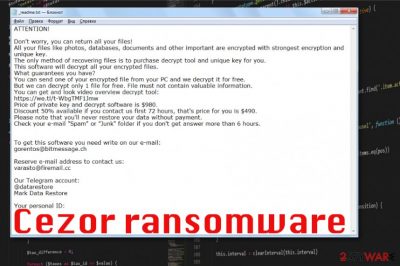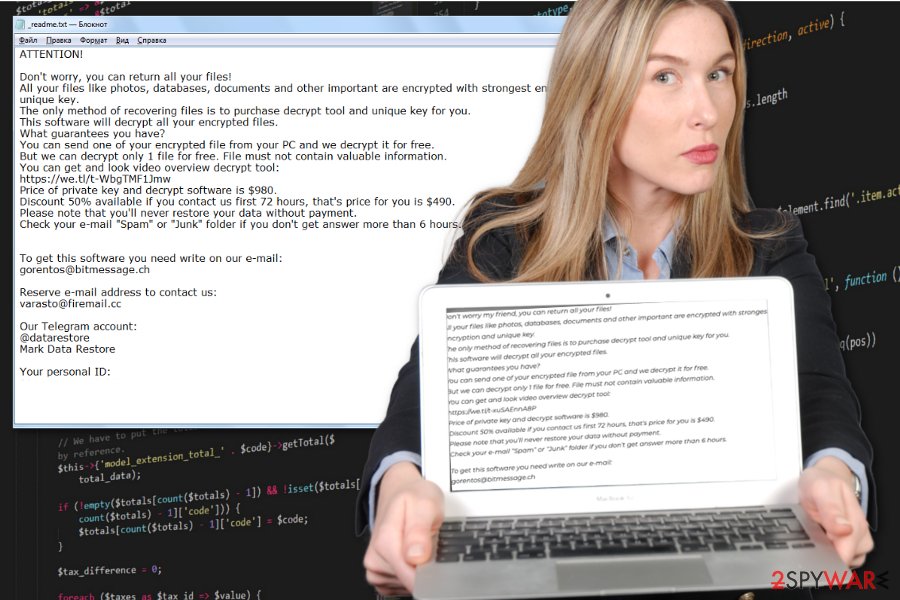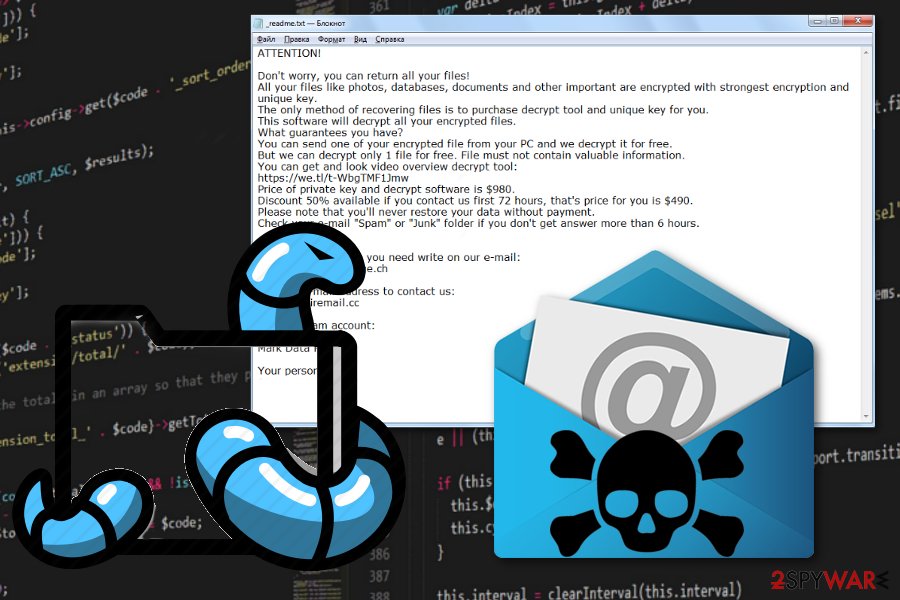Cezor ransomware (Removal Guide) - Decryption Methods Included
Cezor virus Removal Guide
What is Cezor ransomware?
Cezor ransomware is the virus that affects documents, pictures, and audio or video files to demand $980 ransom from victims

Cezor ransomware – cryptovirus that encrypts files found on the infected computer and displays the message with an offer to decrypt this data if the Bitcoin payment is made in time. This message comes in the _readme.txt ransom note file that gets placed on every folder containing encrypted data and on the desktop for the victim to find. All those files that get encoded are marked with .cezor file extension, hence the name of the virus. However, this is a threat that belongs to notorious and extremely active – Djvu ransomware. This cryptovirus family has more than a hundred versions that came out in Spring-Summer of 2019 alone.
The more recent variants in the family that Cezor ransomware virus belongs, come with the same contact emails, ransom note messages, and so on. These facts allow virus developers to release new ransomware after the other. The same contact emails, ransom amount, and ransom note file name run for Godes virus, Litar ransomware, Dalle virus, Lokas virus. Nevertheless, this family of viruses can be decrypted using STOP decrypter, but you may need to wait for the particular update when needed offline keys get added to the database of this tool. For that, check Michael Gillespie updates.
| Name | Cezor |
|---|---|
| Type | Cryptovirus |
| File marker | .cezor |
| Ransom note | _readme.txt |
| Ransom amount | $980/$490 |
| Family | Djvu/STOP virus |
| Decryption | Possible with STOP virus decrypter |
| Elimination | Remove Cezor ransomware from the system using professional anti-malware tool like FortectIntego |
Cezor ransomware is the virus that delivers its malicious script and runs on the system to find various files needed for the later process of encryption and other system alterations. Although the main focus is file locking, cryptovirus starts with a system scan during which your language and other preferences are checked.
In most cases, crypto-malware like Cezor ransomware is set to target particular locations and restrain from affecting particular users in countries like Ukraine, Russia or in the country the particular creators are from. This is the first step virus does before selecting files for encryption.
Then Cezor ransomware attack goes to a step of data encoding, the process employs AES and RSA 1024 military-grade encryption algorithms for this file alteration. During the encryption, data gets changed and becomes useless. Also, all those files get .cezor file extension that marks them from other files on the machine.
When Cezor ransomware virus is done, and all the needed files get encoded, the ransom message appears on the screen as a file _readme.txt and distributes the following text:
Don’t worry my friend, you can return all your files!
All your files like photos, databases, documents and other important are encrypted with strongest encryption and unique key.
The only method of recovering files is to purchase decrypt tool and unique key for you.
This software will decrypt all your encrypted files.
What guarantees you have?
You can send one of your encrypted file from your PC and we decrypt it for free.
But we can decrypt only 1 file for free. File must not contain valuable information.
You can get and look video overview decrypt tool:
https://we.tl/t-xuSAEnnA8P
Price of private key and decrypt software is $980.
Discount 50% available if you contact us first 72 hours, that’s price for you is $490.
Please note that you’ll never restore your data without payment.
Check your e-mail “Spam” or “Junk” folder if you don’t get answer more than 6 hours.To get this software you need write on our e-mail:
gorentos@bitmessage.chReserve e-mail address to contact us:
ferast@firemail.cc
This brief message reveals more details about the virus attack and informs the victim about ransom amount, possible contact methods, and payment transfer. However, we are not recommending to contact Cezor ransomware creators since this can lead to permanent data or money loss.[1]

Do not contact these people that are extorting money from you. Cezor ransomware can also install other threat that runs on the system, especially when you contact those criminals behind the virus because email exchange makes the risk of getting malware even bigger.
Cezor ransomware alters various places on the machine beside the whole file encryption process:
- added new system files;
- installed malware or programs;
- disabled functions and applications;
- deleted files;
- changed registry settings;
- added new startup preferences.
You should rely on Cezor ransomware removal first to change those alterations back to default preferences and possibly clean virus damage from the machine. When the system is virus-free, you can try data recovery methods, use your file backups, and so on. Remember that doing so on the still infected device can lead to more damage.
Remove Cezor ransomware with anti-malware tool and scan the machine thoroughly to ensure that this threat is not going to repeat itself in the future. Since researchers have discovered flaws in the malicious code, this threat is decryptable. For that, you should store encoded files and then clean the system. Before using the decryption tool listed below the article and in the table above, clean the system entirely with FortectIntego.

Infections spread around via payload droppers included as email attachments
Payload file that places a malicious script on the machine and infects the targeted device gets loaded from an unsuspected email that has file attachments or direct links int he notification itself. Such files may be PDFs, documents, or even executables. Malicious macros get triggered on such file once the document is downloaded and opened on the PC.
Such infected emails can look legitimate enough not to raise any questions because malicious actors pose as companies, services, and makes their emails like messages from DHL, FedEx, or UPS about your shipment or invoice. People tend to use such services, so victims open the email without questioning the legitimacy.
You should pay closer attention to such notifications and delete emails once you receive suspicious one. Clean the email box more often and avoid downloading content from shady websites or email directly. Such files may also deliver worms or trojans designed to drop ransomware on the machine directly.
Get rid of Cezor ransomware with professional security tools like antivirus programs
Although Cezor ransomware virus developers claim they are the only ones who can recover your files, restoring data on the affected computer can be especially difficult, especially when ransomware deletes important files or disables programs and affects crucial processes on the machine.
You can try to remove Cezor ransomware manually, but all the changes still need to be reversed and altered back. This is not easily doable, especially when the person is less skilled PC user. This is the reason why experts[2] recommend using professional automatic tools and cleaning the system fully.
We also suggest getting the professional anti-malware tool for Cezor ransomware removal because such programs like FortectIntego, SpyHunter 5Combo Cleaner, or Malwarebytes can detect this virus, malicious files, and applications associated with the cryptovirus and remove them while improving the general performance of the device. Choose the program wisely and base your selection of malware detection rate because there are many different databases used by AV tools.[3]
Getting rid of Cezor virus. Follow these steps
Manual removal using Safe Mode
Reboot the machine in Safe Mode with Networking and then run the system scan to remove Cezor ransomware completely
Important! →
Manual removal guide might be too complicated for regular computer users. It requires advanced IT knowledge to be performed correctly (if vital system files are removed or damaged, it might result in full Windows compromise), and it also might take hours to complete. Therefore, we highly advise using the automatic method provided above instead.
Step 1. Access Safe Mode with Networking
Manual malware removal should be best performed in the Safe Mode environment.
Windows 7 / Vista / XP
- Click Start > Shutdown > Restart > OK.
- When your computer becomes active, start pressing F8 button (if that does not work, try F2, F12, Del, etc. – it all depends on your motherboard model) multiple times until you see the Advanced Boot Options window.
- Select Safe Mode with Networking from the list.

Windows 10 / Windows 8
- Right-click on Start button and select Settings.

- Scroll down to pick Update & Security.

- On the left side of the window, pick Recovery.
- Now scroll down to find Advanced Startup section.
- Click Restart now.

- Select Troubleshoot.

- Go to Advanced options.

- Select Startup Settings.

- Press Restart.
- Now press 5 or click 5) Enable Safe Mode with Networking.

Step 2. Shut down suspicious processes
Windows Task Manager is a useful tool that shows all the processes running in the background. If malware is running a process, you need to shut it down:
- Press Ctrl + Shift + Esc on your keyboard to open Windows Task Manager.
- Click on More details.

- Scroll down to Background processes section, and look for anything suspicious.
- Right-click and select Open file location.

- Go back to the process, right-click and pick End Task.

- Delete the contents of the malicious folder.
Step 3. Check program Startup
- Press Ctrl + Shift + Esc on your keyboard to open Windows Task Manager.
- Go to Startup tab.
- Right-click on the suspicious program and pick Disable.

Step 4. Delete virus files
Malware-related files can be found in various places within your computer. Here are instructions that could help you find them:
- Type in Disk Cleanup in Windows search and press Enter.

- Select the drive you want to clean (C: is your main drive by default and is likely to be the one that has malicious files in).
- Scroll through the Files to delete list and select the following:
Temporary Internet Files
Downloads
Recycle Bin
Temporary files - Pick Clean up system files.

- You can also look for other malicious files hidden in the following folders (type these entries in Windows Search and press Enter):
%AppData%
%LocalAppData%
%ProgramData%
%WinDir%
After you are finished, reboot the PC in normal mode.
Remove Cezor using System Restore
Your machine can also get recovered in a previous state by using the System Restore feature of your Windows machine
-
Step 1: Reboot your computer to Safe Mode with Command Prompt
Windows 7 / Vista / XP- Click Start → Shutdown → Restart → OK.
- When your computer becomes active, start pressing F8 multiple times until you see the Advanced Boot Options window.
-
Select Command Prompt from the list

Windows 10 / Windows 8- Press the Power button at the Windows login screen. Now press and hold Shift, which is on your keyboard, and click Restart..
- Now select Troubleshoot → Advanced options → Startup Settings and finally press Restart.
-
Once your computer becomes active, select Enable Safe Mode with Command Prompt in Startup Settings window.

-
Step 2: Restore your system files and settings
-
Once the Command Prompt window shows up, enter cd restore and click Enter.

-
Now type rstrui.exe and press Enter again..

-
When a new window shows up, click Next and select your restore point that is prior the infiltration of Cezor. After doing that, click Next.


-
Now click Yes to start system restore.

-
Once the Command Prompt window shows up, enter cd restore and click Enter.
Bonus: Recover your data
Guide which is presented above is supposed to help you remove Cezor from your computer. To recover your encrypted files, we recommend using a detailed guide prepared by 2-spyware.com security experts.If your files are encrypted by Cezor, you can use several methods to restore them:
When you need an alternative solution for decryption after Cezor ransomware encryption, try Data Recovery Pro
You should try Data Recovery Pro for files accidentally deleted by you or encrypted by this notorious virus
- Download Data Recovery Pro;
- Follow the steps of Data Recovery Setup and install the program on your computer;
- Launch it and scan your computer for files encrypted by Cezor ransomware;
- Restore them.
Windows Previous Versions feature helps with files after the ransomware attack
When System Restore gets enabled, you can rely on Windows Previous Versions for file recovery
- Find an encrypted file you need to restore and right-click on it;
- Select “Properties” and go to “Previous versions” tab;
- Here, check each of available copies of the file in “Folder versions”. You should select the version you want to recover and click “Restore”.
ShadowExplorer is the method for file restoring purposes
When Cezor ransomware deletes Shadow Volume Copies, you cannot use it for file restoring. In other cases, ShadowExplorer is capable of data recovery
- Download Shadow Explorer (http://shadowexplorer.com/);
- Follow a Shadow Explorer Setup Wizard and install this application on your computer;
- Launch the program and go through the drop down menu on the top left corner to select the disk of your encrypted data. Check what folders are there;
- Right-click on the folder you want to restore and select “Export”. You can also select where you want it to be stored.
Cezor ransomware can be decrypted
It is possible to decrypt files encrypted and marked with .cezor with STOP virus decrypter
Finally, you should always think about the protection of crypto-ransomwares. In order to protect your computer from Cezor and other ransomwares, use a reputable anti-spyware, such as FortectIntego, SpyHunter 5Combo Cleaner or Malwarebytes
How to prevent from getting ransomware
Stream videos without limitations, no matter where you are
There are multiple parties that could find out almost anything about you by checking your online activity. While this is highly unlikely, advertisers and tech companies are constantly tracking you online. The first step to privacy should be a secure browser that focuses on tracker reduction to a minimum.
Even if you employ a secure browser, you will not be able to access websites that are restricted due to local government laws or other reasons. In other words, you may not be able to stream Disney+ or US-based Netflix in some countries. To bypass these restrictions, you can employ a powerful Private Internet Access VPN, which provides dedicated servers for torrenting and streaming, not slowing you down in the process.
Data backups are important – recover your lost files
Ransomware is one of the biggest threats to personal data. Once it is executed on a machine, it launches a sophisticated encryption algorithm that locks all your files, although it does not destroy them. The most common misconception is that anti-malware software can return files to their previous states. This is not true, however, and data remains locked after the malicious payload is deleted.
While regular data backups are the only secure method to recover your files after a ransomware attack, tools such as Data Recovery Pro can also be effective and restore at least some of your lost data.
- ^ Erica Antony. Paying Won’t Always Bring Data Back. Channelpartnersonline. News, analysis and commentary.
- ^ LosVirus. Losvirus. Spyware related news.
- ^ Cezor AV detection rate. Virustotal. Online malware scanner.





















